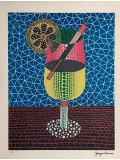
| Period | Contemporary (1945-today) |
|---|
| Period | Contemporary (1945-today) |
|---|
Yayoi Kusama is internationally renowned for her monumental and immersive installations. They have inspired artists such as Carolee Schneemann, Yoko Ono, and Damien Hirst, and are exhibited in some of the most significant contemporary art venues, including the Museum of Modern Art in New York, the Centre Pompidou in Paris, and the Venice Biennale.
Born in Nagano, Japan, in 1929, she began drawing from a very young age. She suffered from hallucinations early on. While looking at a flower-patterned tablecloth and then turning her head towards the ceiling, she realized that the image of dots was still there. Her hallucinations would become a prevalent theme in her work, particularly those famous dots. She attended Hiyoshigao High School and studied traditional and modern Japanese painting.
In the patriarchal Japanese society, it was rare to see women artists. As a result, her parents, especially her mother, were against her artistic pursuits. However, this opposition only fueled her art and strengthened her convictions. She also broke away from the overly traditional Japanese education, drawing inspiration from Western models and seeking more freedom.
At the age of 27, she moved to Seattle and then to New York, where she struggled to make a living. She began exhibiting alongside avant-garde artists like Yves Klein, Andy Warhol, and Jasper Jones. She frequently collaborated with her artist friend Donald Judd, presenting increasingly provocative works. Her psychedelic art (bordering on the hippie movement) in the 1960s was highly avant-garde and aligned with the pop art movement.
She started creating more Happenings (spontaneous performances that required audience participation) and performances. She became famous for her "naked protests," politically charged demonstrations where she would often be arrested by the police. In 1964, her installation at the Gertrude Stein Gallery achieved immense success. She became known for organizing events in the bottom of her attic, where she lay on a mattress covered in phallic shapes and dots. In 1966, she won the Venice Biennale with "Garden of Narcissus," an installation on the lawn of the Italian pavilion filled with 1,500 sparkling balls. In 1993, she was invited back to the Venice Biennale, this time officially. In 1973, she returned to Japan exhausted and, in 1977, was admitted to a psychiatric hospital, where she lived opposite her studio.
Her art allowed her to address her hallucinations and phobias, such as the fear of sex, which stemmed from her father's adultery with her mother. Her art is provocative and daring but serves the feminist and anti-male beliefs she developed while growing up in Japan. Art gave meaning to her life. She also established her own museum in Tokyo and remains highly active in the art world.
You must be logged in to post a question or a comment.
Click here to log in
